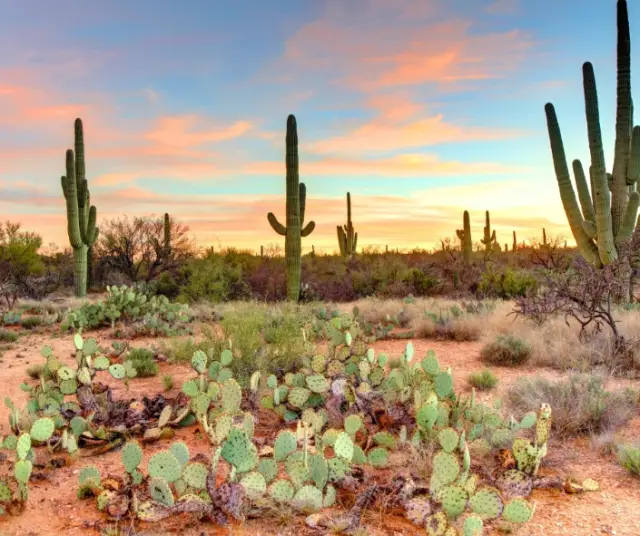Sustainable gardening has become increasingly relevant in our society, driven by environmental awareness and the need to conserve natural resources. In this context, waterless plants have become a popular option for those who want to maintain a lush garden without relying heavily on constant watering.
In the current context, where environmental awareness and the search for more sustainable practices have become imperative, sustainable gardening emerges as an increasingly attractive option. Within this fascinating green universe, drought-resistant plants stand out as true protagonists, offering the possibility of maintaining lush and vibrant gardens without sacrificing a significant amount of water.
These plants have developed unique mechanisms throughout evolution to survive and thrive in conditions of water scarcity. By understanding their physiology and the adaptations they have developed, gardeners can create harmonious and sustainable environments, while reducing dependence on finite water resources.
Succulents: Water Resistant Jewelry
Succulents stand as true jewels within the kingdom of waterproof plants, captivating gardeners and nature lovers with their exquisite combination of shapes, colors and resistance. These plants, known for their thick, fleshy leaves, have perfected the art of survival in arid conditions, becoming ideal allies for those who want to grow gardens without requiring large amounts of water.
Succulents offer a diversity of options to satisfy all aesthetic tastes. Their unique shapes, ranging from compact rosettes to more slender, spiraling structures, add a touch of elegance to any green space. But, beyond their aesthetic appeal, these plants are true examples of evolutionary adaptation to challenging environments.
The key to the resistance of succulents lies in their ability to store water in their tissues. Their leaves, often thick and filled with liquid, act as reservoirs that allow them to survive in situations of prolonged drought. This unique mechanism not only gives them a unique look but also makes them suitable for environments where other plants might falter.
Caring for succulents involves understanding their specific needs. These plants prefer well-drained soil and sunny environments, replicating the conditions of their native habitats. Oversaturation of the soil should be avoided as it can lead to problems such as root rot. Additionally, watering should be moderate, allowing the substrate to dry between waterings to mimic the natural cycle of low rainfall.
Cactus: Elegance and Resistance in a Prickly Package
Cacti are emblematic of drought resistance. Their ability to store water in their stems and leaves allows them to thrive in dry, desert environments. From the snowball cactus to the majestic saguaro, we'll explore the wide range of cacti available and how to harmoniously integrate them into your garden design.
Drought Resistant Native Plants
Another strategy for creating a drought-resistant garden is to incorporate native plants. These species are naturally adapted to local climatic conditions and require less water and care compared to introduced plants. We will discover native plants from various regions and how they can enrich your garden while promoting biodiversity.
Lavenders and Rosemary
Herbs like lavender and rosemary not only add an aromatic touch to your garden, but they are also drought resistant. We'll explore the unique properties of these herbs, how to grow them successfully, and how they can contribute to a sustainable, low-maintenance garden.
Water Conservation Strategies in Gardening
In addition to choosing drought-resistant plants, it is essential to adopt gardening practices that conserve water. From choosing mulch materials to implementing efficient irrigation systems, we'll offer practical tips to maximize water efficiency in your garden.
Container Gardening
Container gardening provides a versatile solution for growing drought-resistant plants. We will explore how to select the right containers, substrate choice and watering management to ensure an optimal environment for plants, even in limited spaces.
Maintenance and Care of Drought Resistant Plants
Proper maintenance and care of drought-resistant plants plays a crucial role in creating and preserving sustainable, low-maintenance gardens. While these plants have evolved to thrive in water-scarce conditions, they still require attention and care to ensure their health and vitality over time.
One of the distinctive characteristics of these plants is their ability to adapt to environments with limited water resources, but this does not mean that they are invulnerable. Understanding their specific needs is essential to maintaining a drought-resistant garden that is vibrant and healthy.
First of all, choosing a suitable floor is essential. A well-drained substrate prevents water from accumulating around the roots, reducing the risk of disease and rot. Adding organic matter to soil can improve moisture retention without compromising drainage capacity.
Watering, although less frequent compared to thirstier plants, should be strategic. It is crucial to allow the substrate to dry between waterings to mimic the natural conditions of drought-resistant plants. The general rule is to prioritize deep, less frequent watering instead of shallow and frequent watering, encouraging the roots to seek water in the deeper layers of the soil.
Regular pruning also plays an important role in maintaining these plants. Removing dry or damaged leaves not only improves its aesthetics, but also stimulates the growth and overall health of the plant. Additionally, selective pruning can help shape the plant and control its size, preventing it from becoming invasive.
Fertilization should be done in moderation and preferably using organic fertilizers. Too many nutrients can encourage excessive, unbalanced growth, which can make the plant more susceptible to diseases and pests.
Case Studies: Sustainable Gardens that Inspire
We will explore case studies of sustainable gardens that have adopted innovative approaches to incorporating drought-resistant plants. These practical examples will offer inspiration and guidance for those looking to transform their own green space.
With the information and tips provided in this article, you will be well equipped to embark on the exciting and rewarding experience of creating a sustainable oasis in your own home.
